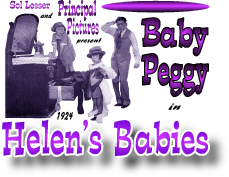

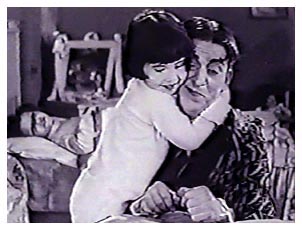 Q: What are your memories of Edward Everett Horton
and Clara Bow?
Q: What are your memories of Edward Everett Horton
and Clara Bow?
Cary: Horton was especially close to me during that filming,
and I remember he taught me how to play Parcheesi. He was very,
very friendly and really great, and we got along fine.
Clara Bow played his girlfriend, and it was one of her first films. I know now that she was being driven very hard by B.P. Schulberg who had her under contract. He was loaning her out to other studios including her part in this film. She would leave the set at 5 p.m. with red-gold, glossy curls, and she'd come back the next morning blonde in a wind-blown bob. We couldn't figure out what was going on, and, of course, the script girl was going wild over this. She didn't seem to have any conscience about it, and it turned out she was working these different jobs where she had to have different hair-do's. She just didn't realize which film she was on. This happened a couple of times. It wasn't every day, but certainly more than once.
She had earned a rather bad reputation. I overheard my father and some of the other men speaking rather badly about her. How guilty she was, God only knows. But she was nice to me. She was timid, very timid.
Q: Did you ever cross paths again with Horton
or Clara Bow after this movie?
Cary: No, I didn't. We left Hollywood
in 1925 and by the time I returned in 1932, her career was fading.
She was stricken with "mike fright."
Q: Where did you do the filming?
Cary: We did some nice locations, out
in the valley somewhere. That's where we did the scene in the
gypsy camp, and these were real gypsies. Obviously, they were
cheaper than actors. I was at their place for quite awhile. I
was in their wagons, and they were all spangled and decorated
and everything. I had heard the stories about gypsies stealing
children, but, of course, when you came to work, all the rules
were 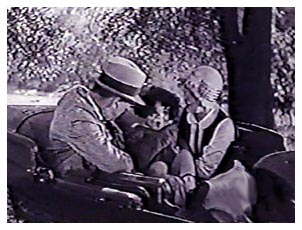 set aside. We spent
three or four days out there, maybe a week. It made a deep impression
on me. They were nice to me, and they told fortunes.
set aside. We spent
three or four days out there, maybe a week. It made a deep impression
on me. They were nice to me, and they told fortunes.
The family home. . . that was in the valley, too. It was a very pretty house. There were two locations. Clara Bow's home in the film was located in Hollywood, but the big family home with the columns was out in the valley. The inside was a set. We shot some scenes in front of the house that we used in Hollywood. The rest was on the set. The part where I was walking around the roof to go in the window on top of the house - it was only a few feet off the ground. They had some long shots, but they were done by a double. God knows they weren't going to make me walk around on a roof! I remember it was an indoor set.
Q. What about the scene where you climbed
the tree to retrieve the doll?
Cary: Oh, that was the most memorable
one of them all. We were supposed to jump out of the tree when
the car came underneath, and, actually, when they told Jeanne
she was going to have to climb the tree and jump into the car,
she screamed and started to cry and said she wouldn't do it. She
couldn't do it. Later, after seeing the film again, I've noticed
that she still has tears on her face in that scene, although she
only had to climb a little ways up on a limb. But anyway, my father
said to me, 'You'll do it. You're not afraid.' So I climbed the
tree. There are two different cars in that scene. There's one
when they are driving up, and the other one that I jumped into
is my own Dusenburg, father's own Dusenburg (the photo below
shows Baby Peggy and her family in the Dusenburg - photo courtesy
of Diana Serra Cary). It had a tonneau, a window between the
seats and two wind flaps. Our Dusenburg was a bright red.
So I got in the tree and was hanging by the limb, and I really didn't like that, because I'm terrible at timing. I can't gauge speed - coming at me or going from me. I couldn't time that car coming toward me, and it would have been disastrous if I had dropped either in front of the car or behind it.
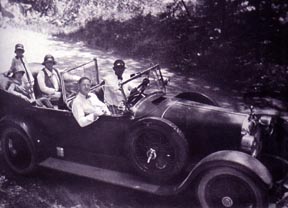 Q. The
scene shows you hanging from the limb, and then cuts to the car
seat as you drop into it. We don't see the tree in that frame.
Q. The
scene shows you hanging from the limb, and then cuts to the car
seat as you drop into it. We don't see the tree in that frame.
Cary: I actually did drop fom the tree
into the back seat of the car. It wasn't all that high, but it
struck me as awfully high. I was really worried about it. I didn't
talk to my parents much. I listened a lot, but I didn't ever tell
them there was something I didn't like or was afraid of. So I
just didn't tell them. And that was one of the times I didn't
tell my father I was scared. I hit it just right on target. I
shut my eyes and landed OK. It really wasn't much of a stunt,
but if I had missed it, it wouldn't have been good.
After the jump, Jeanne was placed in the car, and she was still crying. (Jeanne is shown in the car with her head on Clara Bow's shoulder and does appear to have tears on her eyes.)
I later knew Jeanne - she came to school at Lawlor's (Professional School for movie kids that Cary attended in the mid-1930's), and she turned out to be a real flirt . . . for those times. I was very Victorian, and that shocked me. She had been so passive and meek as a little girl. She later married happily out of the business and had one or two children. When I came back from Mexico (in the early 1970's), someone told me she had died and left her memorabilia from her career to the Motion Picture Academy.
Q. Jeanne Carpenter seemed to be somewhat
conscious of the camera in "Helen's Babies," even looking
at the camera during one scene; however, you seemed to be oblivious
to a camera.
Cary: The first rules I ever heard
when I was a little girl - two things -- "don't look at the
camera," and the other was "film is expensive and time
is money." I never  wasted
a scene, if possible. At Century, it was good training, I'll tell
you. They didn't give you a second chance very often. I used to
think you'd get boiled in oil if you had to do a retake. The thing
with Jeanne was that she was easily distracted, and I wasn't.
My whole training had been concentration, you know. I played like
there was nobody there but me . . . or the the other players.
Jeanne -- there was something insecure about her, like a flickering
lightbulb. Her brother, Chuck (Francis) Carpenter, had
been in those Franklin Kiddie Pictures (made by Fox c. 1917-1918).
The little girl opposite him, as you know, was Virginia Corbin.
He was a natural comic. He was so funny. And in high school, he
was just a riot, a one-man riot. Jeanne wasn't like her brother
at all.
wasted
a scene, if possible. At Century, it was good training, I'll tell
you. They didn't give you a second chance very often. I used to
think you'd get boiled in oil if you had to do a retake. The thing
with Jeanne was that she was easily distracted, and I wasn't.
My whole training had been concentration, you know. I played like
there was nobody there but me . . . or the the other players.
Jeanne -- there was something insecure about her, like a flickering
lightbulb. Her brother, Chuck (Francis) Carpenter, had
been in those Franklin Kiddie Pictures (made by Fox c. 1917-1918).
The little girl opposite him, as you know, was Virginia Corbin.
He was a natural comic. He was so funny. And in high school, he
was just a riot, a one-man riot. Jeanne wasn't like her brother
at all.
Q. What sort of direction were you given
during the scene where you're trying unsuccessfully to stuff the
starched collars back into the box?
Cary: I was simply told that I was
to put them in and get them tight. . . and they would pop out,
and I was to put them back in again. As usual, it was a case of,
"OK, do it again. OK, that was a good one, but let's do it
again just to be sure." So they must have just have kept
saying, "Do it again."
Q. You're re-rolling these collars and trying
to hold each one together even putting one between your knees
so it won't unroll again.
Cary: "Yes, it was just my resourceful
way of trying to fit them back in the box. I was usually left
to my own resources.
Director William Seiter had a "gag man" who worked only with him. I thought he had worked at Century, but when I interviewed him in 1976, he said he never worked for Century, only for Seiter. Well, this was Lewis Milestone, the Oscar-winning director of "All Quiet on the Western Front" (1930).
When I first saw that film as an adult, probably
20 years ago, I remember I was very embarrassed about the scene
where I'm trying to put the collars back in the box. It 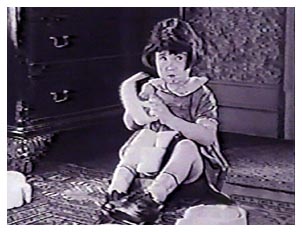 seemed to go on and on, but that
was a Lewis Milestone trick dating back to his earlier years in
silents. They really had to do things repeatedly because people
didn't "read" silent films very well, especially children.
I remember I kept thinking when I was watching it, 'Enough's enough!
We get the message!" but, given the times, it wasn't.
seemed to go on and on, but that
was a Lewis Milestone trick dating back to his earlier years in
silents. They really had to do things repeatedly because people
didn't "read" silent films very well, especially children.
I remember I kept thinking when I was watching it, 'Enough's enough!
We get the message!" but, given the times, it wasn't.
Q. I found a review for "Helen's Babies"
in Variety, but it doesn't look as if the New York Times or Harrision's Reports did a review on it.
Cary: Critics didn't do much with child star films, you
know. . . although when I was in London, I went to the British
Film Institute, and one of the reviews they found for me, believe
it or not, was a four-page review of "The Law Forbids"
(in which Baby Peggy appeared in 1924), which was a Universal
Picture, and it was a very literate and interesting review. "Captain
January" also got long reviews, but I don't think I've ever
seen more than a cursory one of "Helen's Babies."
Q. Although a Photoplay review was
positive, the Variety review wasn't entirely favorable.
Cary: They ran it in Pordenone in 2004,
and the people just went wild over it; they loved it. It was a
very successful film, but it was made for the audience it was
made for, you know. Of course, it was based on a popular book.
Lesser's ads for the movie leaned all over the success of this
book. When he promoted the film, he promoted both "Captain
January" and "Helen's Babies" at the same time
because they were made virtually back to back.
We went on a personal appearance tour for "Captain January," and we also did a brief tour for "Helen's Babies," just a few stops, whereas for "Captain January," I appeared in New York, and Chicago and Kansas City - you know, because these were the major houses in the major cities.
I was supposed to do "Heidi" after "Captain January." It was a much stronger and more popular story than "Helen's Babies," although "Heidi" was a drama and not a comedy. The love interest in the story ("Helen's Babies") was weak. There was really no reason for him (Horton) to have a girlfriend, but they had to throw it in. Horton was more well-known as a comic relief, and I thought he was very good in it. He almost stole the picture. . . but Clara Bow's role lacked character.
Q. Any final thoughts on "Helen's Babies."
Cary: Among my feature films, it was
the lightest one I ever did. It was a comedy, but it had a story.
I had come out of two and half years in slapstick and then did
three feature films at Universal that were melodramas and then
"Captain January" for Sol Lesser, which was also a melodrama.
The main thing about it was that it was not a heavy film, it was
a comedy. To that degree, I felt more at home in it.
Copyright 2006 by Tim Lussier. All rights reserved.